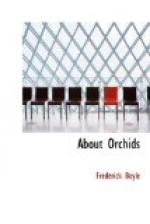Of Oncidiums there are many that demand stove treatment. The story of Onc. splendidum is curious. It first turned up in France some thirty years ago. A ship’s captain sailing from St. Lazare brought half a dozen pieces, which he gave to his “owner,” M. Herman. The latter handed them to MM. Thibaut and Ketteler, of Sceaux, who split them up and distributed them. Two of the original plants found their way to England, and they also appear to have been cut up. A legend of the King Street Auction Room recalls how perfervid competitors ran up a bit of Onc. splendidum, that had only one leaf, to thirty guineas. The whole stock vanished presently, which is not surprising if it had all been divided in the same ruthless manner. From that day the species was lost until Mr. Sander turned his attention to it. There was no record of its habitat. The name of the vessel, or even of the captain, might have furnished a clue had it been recorded, for the shipping intelligence of the day would have shown what ports he was frequenting about that time. I could tell of mysterious orchids traced home upon indications less distinct. But there was absolutely nothing. Mr. Sander, however, had scrutinized the plant carefully, while specimens were still extant, and from the structure of the leaf he formed a strong conclusion that it must belong to the Central American flora; furthermore, that it must inhabit a very warm locality. In 1882 he directed one of his collectors, Mr. Oversluys, to look for the precious thing in Costa Rica. Year after year the search proceeded, until Mr. Oversluys declared with some warmth that Onc. splendidum might grow in heaven or in the other place, but it was not to be found in Costa Rica. But theorists are stubborn, and year after year he was sent back. At length, in 1882, riding through a district often explored, the collector found himself in a grassy plain, dotted with pale yellow flowers. He had beheld the same many times, but his business was orchids. On this occasion, however, he chanced to approach one of the masses, and recognized the object of his quest. It was the familiar case of a man who overlooks the thing he has to find, because it is too near and too conspicuous. But Mr. Oversluys had excuse enough. Who could have expected to see an Oncidium buried in long grass, exposed to the full power of a tropic sun?




